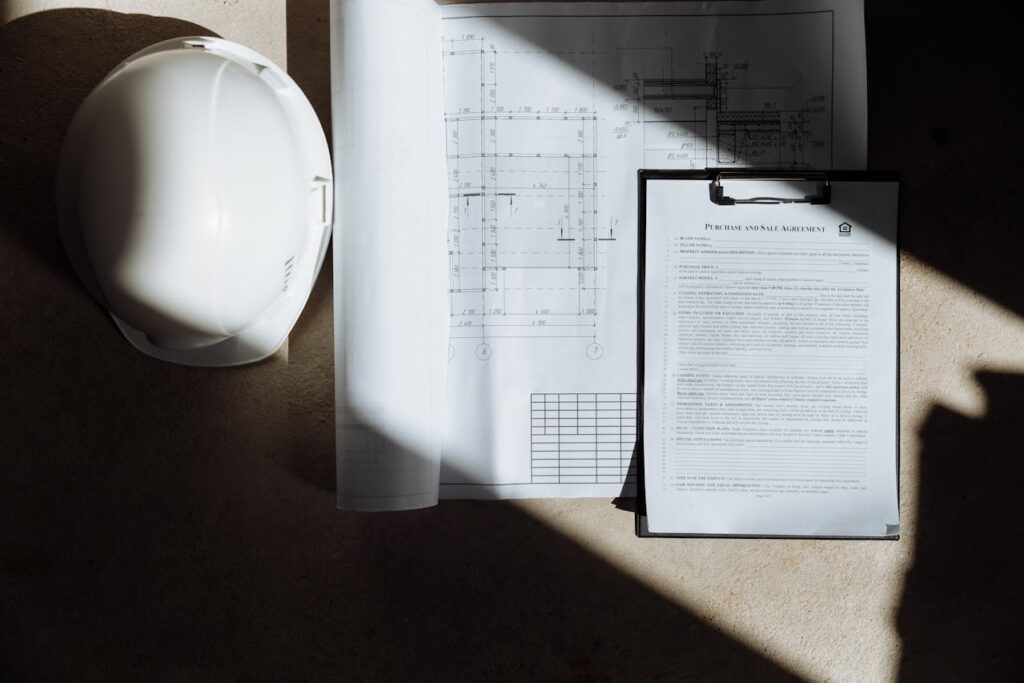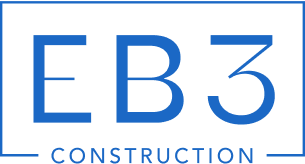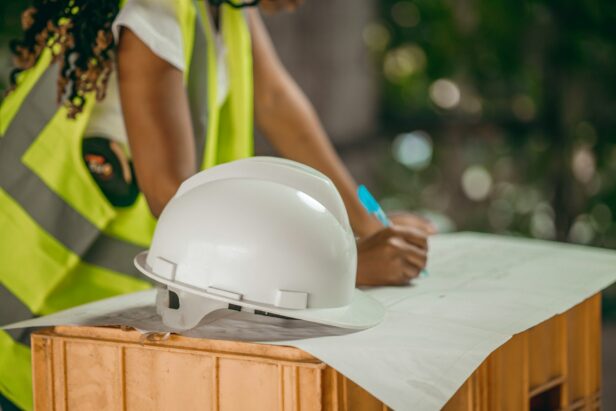Construction waste accounts for roughly 42% of global carbon emissions, making every demolition a missed opportunity. Adaptive reuse project management transforms this challenge into competitive advantage.
We guide the comprehensive process of repurposing existing buildings for new functions while preserving their historic character and enhancing performance. Our approach integrates feasibility analysis, code compliance strategies, sustainability planning, and delivery risk management to turn underutilized structures into vibrant, high-performing spaces that serve modern community needs.
What Lifecycle And Workflows Should Guide Delivery?

We start adaptive reuse projects with a comprehensive feasibility study that evaluates structural integrity, historical significance, and code compliance requirements. This initial assessment guides every decision that follows, from design development through final occupancy. Our teams conduct detailed architectural assessments to document existing conditions, identify preservation opportunities, and flag areas requiring structural reinforcement or systems upgrades.
The engineering assessment runs parallel to architectural documentation, focusing on load-bearing capacity, foundation stability, and mechanical systems compatibility. We examine HVAC infrastructure, electrical distribution, and plumbing systems to determine what can be retained, upgraded, or replaced entirely. These technical evaluations inform our cost estimates and schedule planning while identifying potential complications before they impact construction timelines.
Design Development With Preservation Balance
Design development requires balancing preservation requirements with modern functionality and code compliance. We work through multiple design iterations, testing different approaches to space planning, circulation, and systems integration. Each iteration gets reviewed against preservation standards, user requirements, and budget constraints to ensure the final design delivers value while respecting the building’s historical character.
Our design process includes regular client checkpoints where we present progress, gather feedback, and confirm direction before advancing to the next phase. These structured review points prevent costly revisions later in the process and ensure stakeholder alignment throughout development. We document all design decisions and their rationale to support permit submissions and construction execution.
Permitting And Funding Coordination
Permit acquisition for adaptive reuse projects involves coordinating with multiple authorities having jurisdiction, including historic preservation boards, building departments, and environmental agencies. We begin permit applications early in the design process, submitting preliminary plans to identify potential issues and gather feedback from reviewing officials. This proactive approach reduces approval timelines and prevents last-minute design changes.
Funding coordination happens simultaneously with permitting, as many financing sources require approved plans and confirmed compliance paths. We help property owners navigate historic tax credit applications, energy efficiency incentives, and local grant programs that can significantly improve project economics. Our teams track application deadlines, documentation requirements, and approval timelines to ensure funding commitments align with construction schedules.
Community Engagement Strategies
Early community engagement helps surface local needs, address concerns, and build support for the project. We organize stakeholder meetings, conduct neighborhood surveys, and coordinate with local business associations to understand community priorities and potential resistance points. This input shapes our programming decisions and helps identify opportunities for the project to contribute to broader neighborhood revitalization goals.
Community feedback often reveals practical considerations that technical assessments might miss, such as parking concerns, pedestrian circulation patterns, or desired retail uses. We incorporate this input into our design development and use community support to strengthen permit applications and funding requests. Regular communication throughout the project maintains transparency and demonstrates our commitment to being good neighbors.
Iterative Cycles With Clear Checkpoints
Our delivery workflow uses iterative cycles that allow for continuous refinement while maintaining project momentum. Each cycle includes scope validation, design development, cost estimation, and schedule updates. We structure these cycles around major project milestones such as schematic design completion, permit submission, construction start, and substantial completion.
Client checkpoints occur at the end of each cycle, providing formal opportunities to review progress, approve changes, and confirm next steps. These reviews include updated cost projections, schedule forecasts, and risk assessments that help property owners make informed decisions about project direction. We document all checkpoint outcomes and use them to guide subsequent work phases.
The final review process includes thorough quality control inspections, code compliance verification, and occupancy preparation activities. We coordinate final inspections with authorities having jurisdiction, complete punch list items, and prepare comprehensive closeout documentation including as-built drawings, operation manuals, and warranty information.
Continuous Monitoring And Adaptive Management
We implement continuous monitoring systems that track project performance against baseline schedules, budgets, and quality standards. Real-time data collection through project management software and field reporting allows us to identify issues early and implement corrective actions before they compound. Our monitoring covers construction progress, material deliveries, labor productivity, and safety performance.
Adaptive management principles guide how we respond to unexpected conditions, market changes, or stakeholder requests. Rather than treating changes as disruptions, we evaluate each situation against project objectives and implement solutions that maintain overall delivery goals. This might involve adjusting work sequences, modifying specifications, or reallocating resources to address new priorities while protecting critical path activities.
Our teams maintain detailed project logs that document decisions, changes, and their impacts on schedule and budget. This documentation supports real-time decision-making and provides valuable lessons learned for future adaptive reuse projects. Regular performance reviews help us refine our processes and improve delivery outcomes across our project portfolio.
Which Risks, Codes, And Financing Issues Must Be Managed?
Adaptive reuse projects face layered regulatory challenges that demand proactive management. We encounter zoning changes that can alter project scope mid-stream. Building code upgrades often require full compliance with current standards, even when original structures predate those requirements.
Regulatory Barriers And Community Alignment
Local zoning ordinances frequently shift during project timelines. We coordinate early with planning departments to understand potential changes. Zoning compliance requires continuous monitoring as municipalities update development standards.
Community trust drives project success. Open dialogue surfaces local needs for affordable housing or neighborhood revitalization. We engage residents through public meetings and design charrettes. This alignment prevents resistance that can delay permits or trigger legal challenges.
Hidden Conditions And Change Orders
Older buildings conceal structural surprises. We discover hazardous materials like asbestos or lead paint during demolition. Unexpected structural issues emerge when walls are opened. These conditions trigger change orders that can expand budgets significantly.
Environmental surveys reduce unknowns before construction begins. We conduct selective demolition to expose critical areas early. This approach identifies problems when design flexibility remains highest. Contingency planning accounts for these discoveries in both schedule and budget.
Project Financing And Access To Capital
Adaptive reuse projects require diverse funding sources. We structure financing with strong contingencies for unknown conditions. Traditional construction loans may not cover historic preservation requirements. Access to equity becomes crucial when change orders exceed initial budgets.
Parking requirements pose ongoing constraints. Older buildings often fall short of current parking standards. We negotiate variances or explore shared parking agreements with neighboring properties. Limited flexibility in structural modifications can restrict programming options.
Tax Incentives And Financial Support
Historic tax credits provide substantial project support. Certified projects often qualify for credits around 20% of qualified rehabilitation expenditures. We coordinate with State Historic Preservation Offices early in design development. These incentives require strict adherence to preservation standards.
Energy-efficiency deductions offer per-square-foot tax benefits. Federal and state programs support sustainable upgrades in existing buildings. Property tax abatements reduce long-term operating costs. We explore grants from foundations focused on historic preservation or community development.
Insurance Coverage And Risk Transfer
Builders’ risk policies require careful structuring for renovation work. Standard policies may exclude coverage for existing building portions. We coordinate with brokers to ensure adequate protection during construction phases. Environmental exposures demand specialized coverage for pollution liability.
Professional liability insurance protects against design errors in preservation work. Policy durations may be limited for renovation projects. Extensions become costly as project timelines extend. We plan coverage terms to align with construction schedules and occupancy dates.
How Do Sustainability Goals And Certifications Shape Decisions?

Sustainability targets drive every decision from structural upgrades to material selection. We establish energy performance goals and certification pathways during early project phases to guide technical specifications and contractor coordination. This approach ensures environmental objectives align with preservation requirements.
Embodied Carbon Reduction Through Strategic Reuse
Existing structures offer substantial embodied carbon savings compared to new construction. We retain structural elements, masonry walls, and architectural features whenever structural assessments confirm their viability. This strategy reduces material waste while cutting project carbon footprints by up to 50% according to recent embodied carbon studies.
Material selection focuses on reclaimed lumber, salvaged brick, and refurbished fixtures that maintain building character. We specify low-VOC materials for interior finishes to support indoor air quality certifications. These choices reduce environmental impact while meeting historic preservation standards.
Energy Efficiency Upgrades Within Historic Constraints
HVAC system upgrades require careful integration with existing building envelopes. We design ductwork routes that avoid compromising structural integrity or damaging historic elements. High-efficiency heat pumps and variable refrigerant flow systems often provide the best performance in constrained spaces.
Insulation strategies vary by building age and construction type. We specify thermal improvements that work within historic facade limitations, often using interior approaches or compatible exterior materials. Window upgrades balance energy performance with preservation requirements through storm windows or historically accurate replacements with improved glazing.
Green roofs and solar panels present opportunities where building structure and historic designation allow. We evaluate roof loading capacity and aesthetic impact before proposing these systems. Solar installations often work best on non-visible roof sections or adjacent structures.
Certification Planning For Adaptive Reuse Projects
LEED certification pathways require modification for reuse projects since many credits assume new construction. We coordinate with certification bodies early to identify applicable credits and alternative compliance paths. Historic buildings may qualify for innovation credits through preservation strategies.
Energy efficiency certifications like ENERGY STAR often provide more straightforward paths for existing building improvements. We document baseline performance and projected savings to support certification applications and incentive programs.
Circular economy principles guide our material procurement and waste management strategies. We prioritize material reuse, design for future adaptability, and minimize construction waste through careful deconstruction practices. This approach supports both environmental goals and project economics by reducing disposal costs and material expenses.
What Tools, Teams, And Trade Skills Improve Outcomes?
Technology forms the foundation for successful adaptive reuse execution. We use BIM and 3D scanning to accurately map existing conditions when original as-built drawings are missing or unreliable. Drones equipped with high-resolution cameras and laser scanning systems capture precise measurements of irregular historic structures. This reality capture technology eliminates guesswork and provides the detailed data we need for accurate planning.
Digital collaboration accelerates delivery timelines. Shared digital models allow architecture, engineering, and sustainability teams to work simultaneously rather than in sequence. When structural engineers can overlay their calculations directly onto the 3D scans while preservation specialists mark protected elements in the same model, we identify conflicts early and resolve them before construction begins.
Smart Systems Integration
IoT sensors and building controls deliver measurable performance improvements in historic renovations. We install monitoring systems during construction to track moisture levels, temperature fluctuations, and structural movement in real time. Smart HVAC controls adapt to the unique thermal characteristics of historic buildings while respecting preservation requirements for facade modifications.
Connected systems provide ongoing feedback that helps optimize building performance. Temperature sensors embedded in restored masonry walls alert us to potential freeze-thaw damage before it becomes visible. Automated lighting controls reduce energy consumption while maintaining appropriate illumination for historic interiors.
Specialty Trade Coordination
Historic buildings require specialized craftsmanship that standard construction crews may not possess. We identify and engage stone masons experienced with historic mortar compositions early in the planning process. Slate roofing specialists understand the specific installation techniques needed to maintain weatherproofing while preserving the building’s historic character.
Traditional trades often work with different schedules and procurement timelines than conventional subcontractors. Master plasterers may need weeks to properly cure lime-based materials, while custom millwork requires months of lead time. We coordinate these specialty trades during design development to prevent delays during construction.
Municipal Support Systems
Schedule advantages come from strategic use of existing structure combined with proactive municipal engagement. Expedited permitting programs in many cities prioritize adaptive reuse projects that support urban infill goals. We coordinate with planning departments early to understand available zoning flexibility for mixed-use conversions.
Financial incentives significantly improve project feasibility when properly structured. Historic tax credits provide substantial capital for qualified projects, while energy-efficiency grants offset the cost of building system upgrades. Municipal property tax abatements reduce long-term operating costs, making adaptive reuse competitive with new construction alternatives.
Conclusion And Next Steps

Adaptive reuse project management transforms aging buildings into efficient, community-centered assets that deliver measurable value. These projects reduce waste, preserve embodied carbon, and strengthen neighborhoods through thoughtful preservation and modernization. When we approach them systematically, they create opportunities for faster project delivery while honoring the heritage that defines our communities.
Success requires a structured approach from day one. Begin with a comprehensive feasibility study that evaluates structural integrity, code compliance costs, and market conditions. Set clear sustainability targets early, including energy performance goals and certification pathways that align with your project’s preservation requirements. Build accurate digital models using BIM technology and 3D scanning to capture existing conditions and reduce unknowns that can derail schedules and budgets.
Contact EB3 Construction to discuss how our adaptive reuse expertise can help transform your historic property into a high-performing asset.




